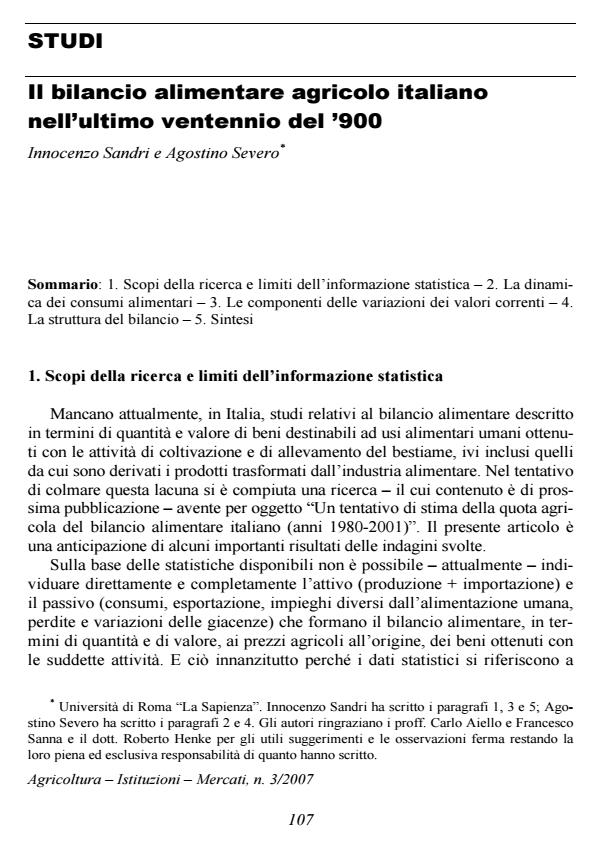Il bilancio alimentare agricolo italiano nell’ultimo ventennio del ’900
Journal title AGRICOLTURA ISTITUZIONI MERCATI
Author/s Innocenzo Sandri, Agostino Severo
Publishing Year 2008 Issue 2007/3
Language Italian Pages 24 P. 107-130 File size 231 KB
DOI
DOI is like a bar code for intellectual property: to have more infomation
click here
Below, you can see the article first page
If you want to buy this article in PDF format, you can do it, following the instructions to buy download credits

FrancoAngeli is member of Publishers International Linking Association, Inc (PILA), a not-for-profit association which run the CrossRef service enabling links to and from online scholarly content.
The Share of Agriculture in the Italian Nutritional Balance During The Last Two Decades of the 20th Century (by Innocenzo Sandri e Agostino Severo) - There are still no studies on the Italian nutritional balance in terms of the quantity and value of agricultural goods (the products of farming and stock breeding). In order to fill this gap we undertook the following research: An attempt to estimate the share of agricultural products in the nutritional balance of the Italian population (1980-2001). This article summarises some of the study’s most important results and covers consumption trends, the structure of the nutritional balance, and the current value of the following items: production, imports, exports, availability, and availability for internal use. Between 1980/82 and 1999/01 the consumption of agricultural goods has grown by 3,7%. As far as nutrients are concerned, there has been an increment of 1,9% (proteins: + 5,1%, lipids: + 17,6%, carbohydrates: -2,6%). The consumption of lipids has also increased, with a rise of 7,5% for those contained in animal fats, 25,9% for those found in olive oil, and 36,5% for lipids in oily seeds. Similarly, both the overall and daily per capita intake of calories have grown by 5,3% and 2,7% (from 3700 to 3800) respectively. This excludes calories ingested with fish, beer, and cocoa. In truth the real calorie intake even if still very high is lower, as the count above includes foods, and especially fats, that get discarded after the cooking process. With regard to current value trends, we identified five variations: quantity, quality, nominal price, inflation, and real price. We discovered a general slump in real prices, compared to variations in the current value, which is relatively more intense for imports than for production and exports. Our study highlighted also the following: international trade has been of paramount importance between 1981 and 2000; processed agricultural goods have been more dynamic than natural agricultural products; both the purchasing power (with the currency having the same purchasing power of 2001) of agricultural products and costs for importers have diminished, while proceeds for exporters have increased; the added value of product processing and distribution has grown faster than the value at origin for imports and especially exports. It derives from it that fluctuations of the agro-industrial trade balance are not indicative of fluctuations of the agricultural trade balance. Finally, it must be noticed that the structure of the balance is varied, with a lower incidence on the value of availability of both production value and internal availability over, respectively, imports and exports.
Innocenzo Sandri, Agostino Severo, Il bilancio alimentare agricolo italiano nell’ultimo ventennio del ’900 in "AGRICOLTURA ISTITUZIONI MERCATI " 3/2007, pp 107-130, DOI: